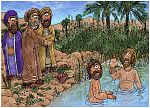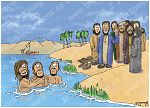Bible Cartoon: John 01 - John the Baptist - Scene 02 - Bethany beyond the Jordan
Click on Add to cart button below shopping cart.
Purchased Bible Cartoons do not have watermarks. Links to Cartoons provided on email once purchase is completed.Bible Book: John
Bible Book Code: 4300102801
Scene no: 2 of 3
Bible Reference & Cartoon Description
John 1:28 (ANIV)
This all happened at Bethany on the other side of the Jordan, where John was baptising.
DRAWING NOTES:
TIME OF DAY:
Unspecified in Bible narrative. I have set this scene in the late morning.
LIGHTING NOTES:
The sun (unseen & high on the right) illuminates this scene, casting shadows below & to the left of figures & objects.
CHARACTERS PRESENT:
John the Baptist, various other people standing in the river Jordan.
RESEARCH/ADDITIONAL NOTES:
This scene illustrates where John the Baptist was baptizing people; which was in Bethany beyond the Jordan. The King James Version names the place as Bethabara, which signifies literally the house of passage, and is thought to be the place where the Israelites passed the river Jordan under Joshua. It seems likely that Bethabara is the same as Bethany beyond the Jordan.
The more familiar Bethany was a village 1.8 miles (3 km) from the city of Jerusalem, on the eastern slope of the Mount of Olives. Incidentally, this 2nd Bethany (near Jerusalem) was where Lazarus, Martha & Mary lived.
The baptism of Jesus by John the Baptist, the act that launched Jesus’ public ministry, most likely took place on the Jordanian side of the Jordan River, in a perennial riverbed called the Wadi Al-Kharrar. The baptismal site of Bethany beyond the Jordan (John 1:28) is near the southern end of the Jordan River, across from the city of Jericho and 5 miles (8 km) south of the King Hussein (or Allenby) Bridge.
Here is the scene without the figures & bird in the foreground.

Background of John 01 – John the Baptist – Scene 02 – Bethany beyond the Jordan
Click on the colour bar below to view/buy this Background:
Background of John 01 – John the Baptist – Scene 02 – Bethany beyond the Jordan
The Jordan River.
The Jordan River (called Nahr Al-Urdun (in Arabic) & Ha-Yarden (in Hebrew)), is found in southwestern Asia, in the Middle East region. It lies in a structural depression (the Jordan Rift Valley) and has the lowest elevation of any river in the world.
The Jordan River is more than 223 miles (360 km) in length. Due to its meandering course, the actual distance between its source (on the slopes of Mount Hermon, on the border between Syria and Lebanon), and its end (emptying into the Dead Sea) is less than 124 miles (200 km). The Jordan River is a good example of an endorheic river, one that doles not draining into an ocean, but to an inland area.
In places The Jordan River resembles more of a stream or creek than a river, being less than 6.5 feet (2 meters) deep and 32.8 feet (10 meters) wide. The walls of the Jordan valley can be bare and steep but are broken by gorges of water.
The surface of the Dead Sea, at an elevation of about 1,410 feet (430 metres) below sea level in the mid-2010s, is the lowest land point on Earth.
A remarkable feature of this valley is its exposure to di?erent natural climatic environments. Its northern part, down to Lake Tiberias (aka The Sea of Galilee), is characterized by a Mediterranean climate, with hot, dry summers and cool, rainy winters. Farther south, the climate the Jordan River flows through becomes progressively drier. The ample (if seasonal water supply) and fertile soils make this valley an extensive agricultural site, attracting farming for thousands of years.
Vegetation of the Jordan River.
Olive, eucalyptus and cedar trees thrive throughout the Jordan Valley.
There is lush vegetation on both banks of the river Jordan, a product of the ready availability of fresh water. I have illustrated the banks of the Jordan River showing reed beds, which include Phragmites australis, (aka The Common Reed), which is a broadly distributed wetland grass that can grow up to 20 feet (6 metres) tall. The leaves are 7–23.5 inches (18–60 centimetres) long and 0.5–2.25 inches (1–6 cm) broad. The flowers are produced in late summer in a dense, dark purple panicle (many branched flower), about 6–15.5 inches (15–40 cm) long. Later the numerous long, narrow, sharp pointed spikelets [1] appear greyer due to the growth of long, silky hairs. These eventually help disperse the minute seeds.
The thickets surrounding the Jordan are referred to in scripture as the “pride” of the Jordan (Zech 11:3). Especially prevalent in this growth are tamarisk, willow, and Euphrates poplar trees. Since the growth is so thick, wild animals find refuge in this area. Nineteenth-century explorers reported seeing lions, tigers, bears, hyenas, jackals, and otters. Jeremiah used the image of a lion coming up from the Jordan’s thickets in his prophecies (Jer 49:19; 50:44).
[Source: https://www.bibleplaces.com/bethanybeyondjordan/]
Out of 162 species of plants found at the Southwest corner of the Dead Sea, 135 species are African in their affinity. In the marshes of Lake Huleh, many acres are covered with the papyrus plant, which became extinct in Egypt long ago, and is now found in Africa only in the Upper Nile beyond the 7th degree of North latitude. The most common trees and plants of the Jordan valley are the castor-oil plant and the oleander, flourishing especially about Jericho, several varieties of the acacia tree, the caper plant, the Dead Sea apple (Solanum Sodomaeum) the oser tree of the Arabs, tamarisks, Agnus casti (a flowering bamboo), Balanites Aegyptiaca (supposed to be the balm of Gilead), Populus Euphratica (a plant found all over Central Asia but not West of the Jordan), and many tropical plants, among which may be mentioned Zygophyllum coccineum, Boerhavia, Indigofera, several Astragali, Cassias, Gymnocarpum, and Nitraria.
[Source: Valley, Jordan – International Standard Bible Encyclopedia]
Great Reed-warbler (bird).
The little bird hanging on to the reed on the right is an Acrocephalus arundinaceus (aka Great Reed-warbler).
Acrocephalidae is the marsh and tree-warbler family.
The Great Reed-warbler typically measures 6.3–8.3 inches (16–21 cm) in length, 9.8 to 11.8 in (25 to 30 cm) in wingspan and weighs 0.78 to 1.34 oz (22 to 38 g). The male & female are identical in colour, as with most warblers, but young birds are richer buff below. The adult has unstreaked brown upperparts and dull buffish-white chin and underparts. The forehead is flattened, and the bill is strong and pointed.
This passerine [2] bird is found in large reed beds, often with some bushes. On their breeding grounds, they are territorial in nature. In their winter quarters, they are frequently found in large groups, and may occupy a reed bed to the exclusion of other birds. Like most warblers, it is insectivorous (eats insect), but it will take other prey items of small size, including vertebrates such as tadpoles. Other food sources including insect larvae, moths, dragonflies, damselflies, beetles, spiders, small fish, and frogs.
Great reed warbler females lay 3–6 eggs in an open cup-nest in reeds.
The Great Reed-warbler breeds in Europe and the west Palearctic [3]. It does not breed in Great Britain, but is an irregular visitor. Its population has in recent decades increased around the eastern Baltic Sea, while it has become rarer at the western end of its range. It is a migratory bird, wintering in tropical Africa. This bird migrates north at a rather late date, and some birds remain in their winter quarters until the end of April.
Source: https://en.wikipedia.org/wiki/Great_reed_warbler]
John 1:28 (KJV)
These things were done in Bethabara beyond Jordan, where John was baptizing.
John 1:28 (AMP)
28 These things occurred in Bethany (Bethabara) across the Jordan [at the Jordan crossing], where John was then baptizing.
[1]
Spikelet – the basic unit of a grass flower, consisting of two glumes or outer bracts at the base and one or more florets above. A spikelet, in botany, describes the typical arrangement of the flowers of grasses, sedges and some other Monocots (grass and grass-like flowering plants (angiosperms)).
[2]
Passerine – relating to or denoting birds of a large order distinguished by having feet that are adapted for perching, including all songbirds.
[3] Palearctic – relating to or denoting a zoogeographical region comprising Eurasia north of the Himalayas, together with North Africa and the temperate part of the Arabian peninsula.





